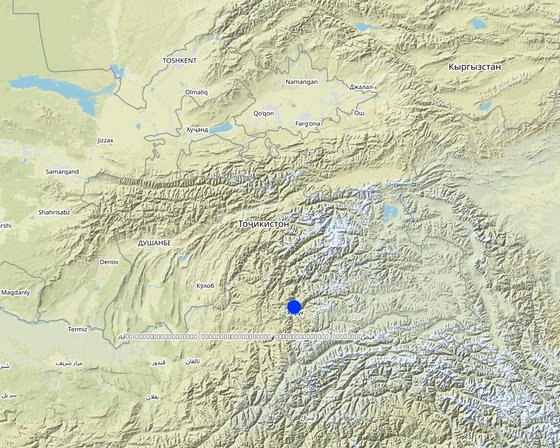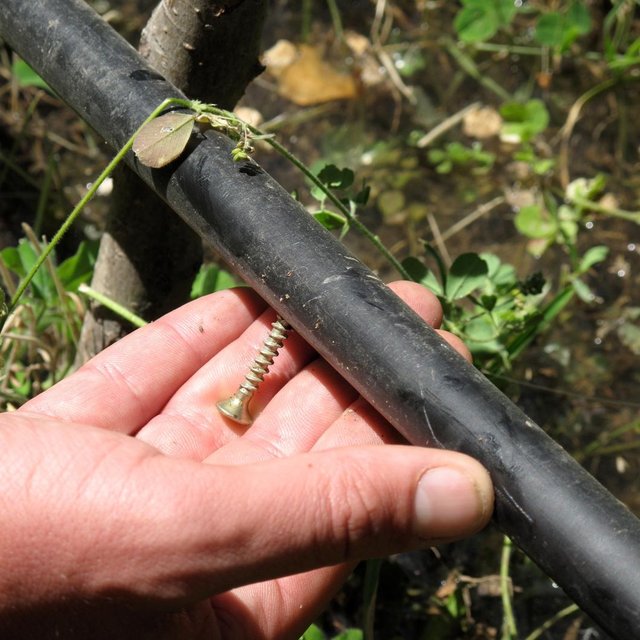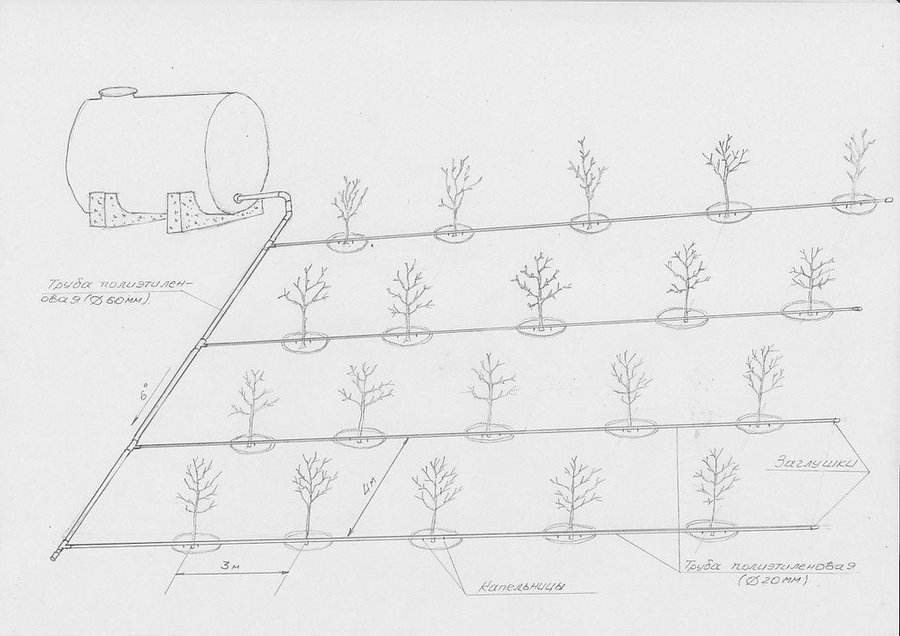



The system consists of a reservoir and polyethylene irrigation tubes and emitters installed along the rows of trees. Water accumulates in the reservoir during spring and early summer when there is no deficit in irrigation water. During the dry summer months water is then used for drip irrigation. Located in the upper part of the system, the reservoir ensures water pressure in the system. Due to the complex local topography, this irrigation method can be used without water pumps since natural water pressure ensures normal functioning of the system. Even though this water saving technology is quite effective, drip irrigation is rarely used since both the construction and maintenance of the system are quite expensive. With the introduction of this technology into the poor mountain communities of GBAO, the overall objective was to make drip irrigation technology cheaper and more easily available to farmers. The objective was achieved by the use of simple polyethylene irrigation tubes, simple screws instead of expensive emitters, and natural water pressure excluding the construction of a water pump station. Water is dripped directly to the roots of the trees, thus excluding loss of water and soil erosion. Fertilisers can be added directly to the water reservoir. This technology allows increased water savings of 50%, and 90% of fertilisers. During the growing period trees are watered once every 6 days.
Purpose of the Technology: The purpose of this technology is to improve the water supply for fruit orchards during the growing period in the arid conditions of the Pamirs where available water is very limited.
Establishment / maintenance activities and inputs: Steps to implement the technology include the following: dig holes for trees, plant trees, establish water reservoir, lay polyethylene tubes, install emitters and regularly clean irrigation system.
Natural / human environment: The plot is located in an arid zone at the height of 2000m above sea level. It is a high mountain area with typical brown soils and slopes up to 60 degrees steepness. Annual precipitation is quite low and mainly occurs in the autumn and winter period. Summers are extremely dry. The main occupations of the local population include agriculture and cattle breeding.

Location: Shugnan, GBAO, Tajikistan
No. of Technology sites analysed:
Spread of the Technology: evenly spread over an area (approx. < 0.1 km2 (10 ha))
In a permanently protected area?:
Date of implementation: less than 10 years ago (recently)
Type of introduction







| Specify input | Unit | Quantity | Costs per Unit (Tajik Somony) | Total costs per input (Tajik Somony) | % of costs borne by land users |
| Labour | |||||
| Tree planting | Persons/day | 2.0 | 11.0 | 22.0 | 100.0 |
| Mounting of drip irrigation system | Persons/day | 5.0 | 25.2 | 126.0 | |
| Equipment | |||||
| Tools | pieces | 5.0 | 1.2 | 6.0 | 100.0 |
| Other Tools | pieces | 5.0 | 2.2 | 11.0 | |
| Polyethylene tube | meters | 2200.0 | 0.445454545 | 980.0 | |
| Watertank | pieces | 1.0 | 600.0 | 600.0 | |
| Plant material | |||||
| Tree seedlings | pieces | 360.0 | 0.675 | 243.0 | 100.0 |
| Fertilizers and biocides | |||||
| Fertilizer | kg | 10.0 | 1.7 | 17.0 | 100.0 |
| Total costs for establishment of the Technology | 2'005.0 | ||||
| Total costs for establishment of the Technology in USD | 450.56 | ||||
| Specify input | Unit | Quantity | Costs per Unit (Tajik Somony) | Total costs per input (Tajik Somony) | % of costs borne by land users |
| Labour | |||||
| Sanitary cutting of trees | Persons/day | 0.6 | 16.66667 | 10.0 | 100.0 |
| Hay harvest | Persons/day | 1.0 | 9.0 | 9.0 | 100.0 |
| Unclogging the irrigation tubes | Persons/day | 1.0 | 11.0 | 11.0 | |
| Equipment | |||||
| Tools (Scissors) | pieces | 2.0 | 2.5 | 5.0 | 100.0 |
| Tool for harvesting | pieces | 1.0 | 2.0 | 2.0 | 100.0 |
| Tools for unclogging tubes | pieces | 2.0 | 2.25 | 4.5 | 100.0 |
| Polyethylene tube | meters | 56.0 | 0.445454545 | 24.95 | 100.0 |
| Water tank | repair | 1.0 | 10.0 | 10.0 | 100.0 |
| Plant material | |||||
| Seedlings tree replacement | pieces | 15.0 | 0.675 | 10.13 | 100.0 |
| Fertilizers and biocides | |||||
| Fertilizer | kg | 10.0 | 1.7 | 17.0 | 100.0 |
| Total costs for maintenance of the Technology | 103.58 | ||||
| Total costs for maintenance of the Technology in USD | 23.28 | ||||
Quantity before SLM: 45kg per ha
Quantity after SLM: 80kg per ha
water availability increase production of fruits
Quantity before SLM: 5 centner/ha
Quantity after SLM: 20 centner/ha
grass between rows used for fodder
Quantity before SLM: bad
Quantity after SLM: high
before natural grass - after alfa alfa
Quantity before SLM: 2- 5per hose
Quantity after SLM: 6-15 per hose
increase of fodder production stimulate livestock development
Quantity before SLM: 0.5 m3/hose
Quantity after SLM: 1-5m3/hose
sanitary cutting of tress
Quantity before SLM: 0
Quantity after SLM: 100%
increased water availability
Quantity before SLM: 10%
Quantity after SLM: 70%
technology helps to use steep slopes
Quantity before SLM: 0
Quantity after SLM: 50%
Quantity before SLM: 10%
Quantity after SLM: 80%
increased harvest
Quantity before SLM: 0
Quantity after SLM: None
Quantity before SLM: 50%
Quantity after SLM: 0%
decreased conflict related to irrigation water use
Quantity before SLM: 0
Quantity after SLM: 50%
increased incomes of poor farmers
After the implementation of the technology the households were protected from negative influence of dry season.
Quantity before SLM: 10%
Quantity after SLM: 60%
Quantity before SLM: 0%
Quantity after SLM: 100%
Quantity before SLM: 100%
Quantity after SLM: 0%
all the water can be absorbed by soil
Quantity before SLM: 0
Quantity after SLM: 10%
transpiration of trees and grass
Quantity before SLM: 0%
Quantity after SLM: 80%
during the dry season
Quantity before SLM: 0%
Quantity after SLM: 20%
Quantity before SLM: 0%
Quantity after SLM: 100%
reduced dry season effect
Quantity before SLM: 0%
Quantity after SLM: 50%